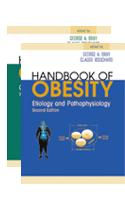Description
Presenting the state of the science in the care of the obese patient plus
contributions from world-renowned experts on the genetic and molecular
foundations of obesity, the two volumes of the Handbook of Obesity, Second
Edition are essential reading for all physiologists, nutritionists,
endocrinologists, bariatricians, dietitians, obesity research scientists,
pharmaceutical researchers, psychiatrists, and graduate and medical school
students in these disciplines.
George A. Bray
Louisiana State University, Baton Rouge, U.S.A.
GEORGE A. BRAY is the Executive Director, Pennington Biomedical Research
Center, Baton Rouge, Louisiana and a Professor of Medicine, Louisiana State
University, Baton Rouge. The author, coauthor, editor, or coeditor of over 500
books, book chapters, and scientific papers, he is the founder of the North
American Association for the Study of Obesity, the President of the
International Association for the Study of Obesity, a Master of the American
College of Physicians, and a member of the American Association for the
Advancement of Science, the American Physiological Society, and the American
Society for Clinical Nutrition, among others. Dr. Bray received the A.B. degree
(1953) from Brown University, Providence, Rhode Island, and the M.D. degree
(1957) from Harvard Medical School, Boston, Massachusetts.
Claude Bouchard
Louisiana State University, Baton Rouge, U.S.A.
CLAUDE BOUCHARD is a Professor of Exercise Physiology, Physical Sciences
Laboratory, Laval University, Ste. Foy, Quebec, Canada. The author or coauthor
of over 450 research papers, he is the Vice President (North America) of the
International Association for the Study of Obesity and a member of the
International Task Force on Obesity of the World Health Organization, among
others. Dr. Bouchard received the B.Ped. degree (1962) in exercise physiology
from the University of Laval, Ste. Foy, Quebec, Canada, the M.Sc. degree (1963)
in exercise physiology from the University of Oregon, Eugene, and the Ph.D.
degree (1977) in anthropological genetics from the University of Texas at
Austin.
전임의 100.0%
Handbook of Obesity : Etiology and Pathophysiology: Second Edition
Table of Contents
History, Definitions, and Prevalence
Historical Framework for the Development of Ideas About Obesity
George A. Bray
Evaluation of Total and Regional Adiposity
Steven B. Heymsfield, Richard N. Baumgartner, David B. Allison, ZiMian Wang,
and Robert Ross
Ethnic and Geographic Influences on Body Composition
Paul Deurenberg and Mabel Deurenberg-Yap
Prevalence of Obesity in Adults: The Global Epidemic
Jacob C. Seidell and Aila M. Rissanen
The Fetal Origins of Obesity
David J. P. Barker
Pediatric Obesity: An Overview
Bettylou Sherry and William H. Dietz
Obesity in the Elderly: Prevalence, Consequences, and Treatment
Robert S. Schwartz
Economic Costs of Obesity
Ian D. Caterson, Janet Franklin, and Graham A. Colditz
Etiology
Genetics of Human Obesity
Claude Bouchard, Louis Perusse, Treva Rice, and D. C. Rao
Molecular Genetics of Rodent and Human Single Gene Mutations Affecting Body
Composition
Streamson C. Chua, Kathleen Graham and Rudolph L. Leibel
Rodent Models of Obesity
David A. York
Primates in the Study of Aging-Associated Obesity
Barbara C. Hansen
Behavioral Neuroscience and Obesity
Sarah F. Leibowitz and Bartley G. Hoebel
Experimental Studies on the Control of Food Intake
Henry S. Koopmans
Diet Composition and the Control of Food Intake in Humans
John E. Blundell and James Stubbs
Central Integration of Peripheral Signals in the Regulation of Food Intake and
Energy Balance: Role of Leptin and Insulin
L. Arthur Campfield, Francoise J. Smith, and Bernard Jeanrenaud
Development of White Adipose Tissue
Gerard Ailhaud and Hans Hauner
Lipolysis and Lipid Mobilization in Human Adipose Tissue
Do


